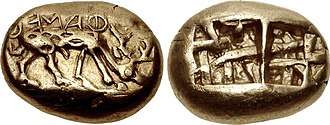Phanes (coin issuer)
Phanes name is attested on a series of early electrum coins, the most ancient inscribed coin series at present known, of Caria, Asia Minor. This group of coins has a Greek legend reading "Phaneōs eimi sēma" (Φάνεως ειμί σήμα)[1] which can be translated either as "I am the badge of Phanes" or as "I am the sign of light" [2] or maybe "I am the tomb of light" or "I am the tomb of Phanes". The celebrated coins of Phanes are known to be amongst the earliest of Greek coins, a hemihekte of the issue was found in the foundation deposit of the Temple of Artemis at Ephesus (this deposit is considered the oldest deposit of electrum coins discovered).
Possible Identifications for "Phanes"
No further certain information exists as to the identity of the Phanes named on these coins. One possibility is that Phanes was a wealthy merchant, another that the coins bearing the name are to be associated with Apollo-Phanes and, due to the Deer, with Artemis (twin sister of the god of light Apollo-Phaneos). Although only seven Phanes type coins were discovered, it is also notable that 20% of all early electrum coins also have the Lion (symbol of Artemis-Potnia Theron) and the sun burst (symbol of Apollo-Phaneos). Alternatively it is stated [3] that the inscribed Phanes maybe was the Halicarnassian mercenary of Amasis, Phanes of Halicarnassus, mentioned by Herodotus,[4] who escaped to the court of Cambyses, and became his guide in the invasion of Egypt in the year B.C. 527 or 525. According to Herodotus, this Phanes was buried alive by a sandstorm, together with 50000 Persian soldiers, while trying to conquer the temple of Amun–Zeus in Egypt [5] nearby the ancient cities of Abydos, Tahta and Nag Hammadi. The fact that the Greek word "Phanes" also means light (or lamp), and the word "sema" also means tomb,[6] makes the coins issued in the name of Phanes famous and controversial.[7]
See also
- Phanes (mythology)
References
- "Electrum stater inscribed with the name of Phanes". British Museum. 2011-09-29. Retrieved 2012-05-21.
- Newton (Num. Chron., 1870, p. 238
- "Full text of "The numismatic chronicle and journal of the Royal Numismatic Society"". Archive.org. Retrieved 2012-05-21.
- Herodotus third book (ch. iv.)
- Herodotus third book
- Iliad 2.814, 6.419
- "Ancient coinage of Ionia". Snible.org. Retrieved 2012-05-21.

.jpg)